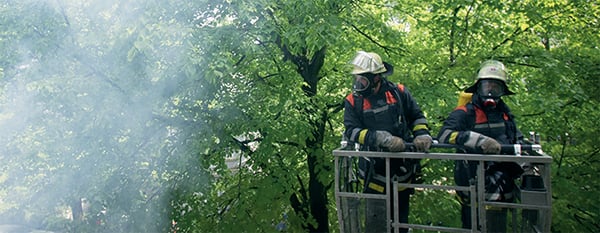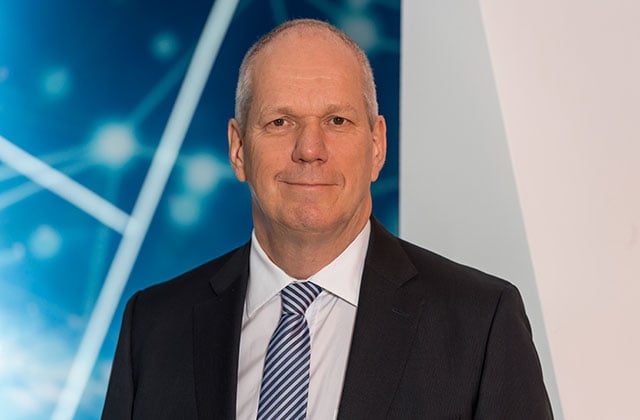- Segments
- Products and solutions
- Products and solutions
- Broadband
- Devices and accessories
- Applications
- Control Rooms
- TETRA and Tetrapol
- Customers
- Ecosystem
- How to buy
- Blog
- EN
“Already today, videos of an incident such as a fire may be posted on social media faster than an alert is received by the fire brigade. If we can filter such information correctly, this will be an enormous enabler. Agencies will gain new agility and efficiency by getting earlier warning. Artificial Intelligence will have a strong role in interpreting the abundance of data to provide actionable insights.”
It is obvious that today’s world is totally connected. People go nowhere today without being connected. Public safety agencies must also have good, secure connectivity with useful bandwidth to perform their work in the modern world.
However, a key question is how to get useful information from the abundance of data in this new world. How can we make sure we can separate fake news from trusted information? How can we obtain actionable intelligence that public safety forces can trust and base their decisions on? This is where Airbus sees a growing role as a trusted partner. Airbus as a safe brand can help to provide the vital information that users need, put it into context and offer the best overview of a situation.
At the same time, all organisations have constrained budgets and need to ensure that their investments are used to the maximum extent. Secondly, public safety agencies are extremely careful in changing systems that are working well. My children are happy to change mobile phones every year, but in the secure communications environment where many more elements need to come together, the approach is and has to be different.
Public safety agencies all know they need broadband but must ensure that when moving to a modern technology they will do so without the risk of ending up with a system not working reliably.
This means that we must provide hybrid solutions that combine the best of both worlds of secure critical communications capabilities and broadband technologies. Broadband will provide fully usable benefits, yet when these networks become inaccessible in times of stress, users still have their TETRA and Tetrapol systems available. It is also important that users have the convenience of one robust terminal and are not forced into using two devices. At Airbus, we are focusing on these needs as a matter of priority.
There are many opportunities in this new, hybrid world and in future 5G when everything comes together. A prime benefit is that broadband connectivity allows critical communications users to receive videos and pictures. As people, we are so much more focused on visuals. A picture can convey much more information more quickly than a voice call.
This is a fantastic opportunity to exchange more information more quickly within and between agencies to prepare the right response and act more efficiently. E.g. a live video feed of what one officer sees allows the other agencies to prepare better support. The world of public safety forces will be substantially more agile and effectively safer.
As for the threats, well we must make sure that while we transition to such a modern world, if there is any kind of failure then the agencies can still do their job. In the 5G world, capabilities such as network slicing will provide the security, performance and reliability users need, but that is in the future and will take time to implement, our hybrid solutions are forming the bridge.
One challenge we face now is how to modernize existing systems with new elements without having to rebuild the infrastructure or make major upgrades over and over again. We need to ensure minimal effort allowing to upgrade to the next technology – ideally as simple as taking out a module, sliding in a new one or even just uploading a new software.
Secondly, there must be a new approach to certification that is not based on network system built for 30 years, but one that assumes upgrades every three to five years. This calls for a modular and more flexible certification approach which some governments already have, although others do not. An analogy is leasing a car, in which regular upgrades are built into the contract.
At Airbus we must explain clearly to our customers the opportunities of this approach and how it can help users to stay ahead of the security challenges they face – this is the most important consideration.
As smart cities develop, which they will independently of how public safety acts, they risk being swamped with information. Already today, videos of an incident such as a fire may be posted on social media faster than an alert is received by the fire brigade. If we can filter the information correctly, this will be an enormous enabler. Agencies will gain new agility and efficiency by getting earlier warning. Artificial Intelligence will have strong role in interpreting the abundance of data to provide actionable insights.

There are many aspects of security to consider. With communications becoming all IP-based in the future, cyber security is vital. Encryption, security of operations centres and continuous monitoring of networks to identify attacks will all become standard. This is essential so that agencies can base their decisions on trusted information.
The communications services that public safety agencies use must also have the availability and bandwidth that users need to do their jobs regardless of what is happening. This is not a trivial challenge.
My advice is to embrace the modern world because if they use outdated technology, blue light forces will not have the full capabilities they need to guarantee our safety. They need elegant solutions to help them complete missions rapidly and efficiently, such as e.g. special apps not available to the general public, like face recognition and vehicle licence plate recognition.
Furthermore, the new generation of employees coming into the forces won’t use outdated systems. Theoretically, they cannot use private devices as that would breach security, but people will always find ways to work around restrictions and that could become very dangerous. If we do not give the new generation of users the modern technology that they use in daily life, then we will not be able to recruit them anymore.
In the longer term, we must work to influence 5G standardisation to ensure security forces can do their work. We are working very hard on this together with the public safety organisations. 3GPP standardisation is happening right now and public bodies must ensure the new standards meet their needs.
One final point I would like to make. Many of the challenges and opportunities I have talked about also apply to many other industries that run critical infrastructure and need new, secure communications. If we talk about critical communications, then we must assume we are talking about ‘critical’ as being essential for sustaining our way of life and that means we have to ensure these industries can communicate as securely as the public safety forces.
Take a look at the 15 most interesting observations from all the interviewees gathered into a printable document. Get the pdf and print out the quote that most inspires you -
Evert Dudok has been Executive Vice President of Communications, Intelligence, and Security (CIS) since the creation of Airbus Defence and Space in 2014. In this role, he is responsible for a wide range of businesses that provide services and solutions related to secure communication, satellite imagery and intelligence, integrated defence and security systems, and cyber security. He is a member of the Airbus Defence and Space Executive Committee.
Dudok began his long career in the aerospace, defence, and security industries as a development engineer at MBB (later DASA, the former aerospace subsidiary of Daimler-Benz AG). He focused on antenna products and technologies for space applications for the first 10 years of his career, before increasingly taking on more commercial and strategic management roles.

Evert Dudok, Executive Vice President of Communications, Intelligence, and Security (CIS), Airbus Defence and Space